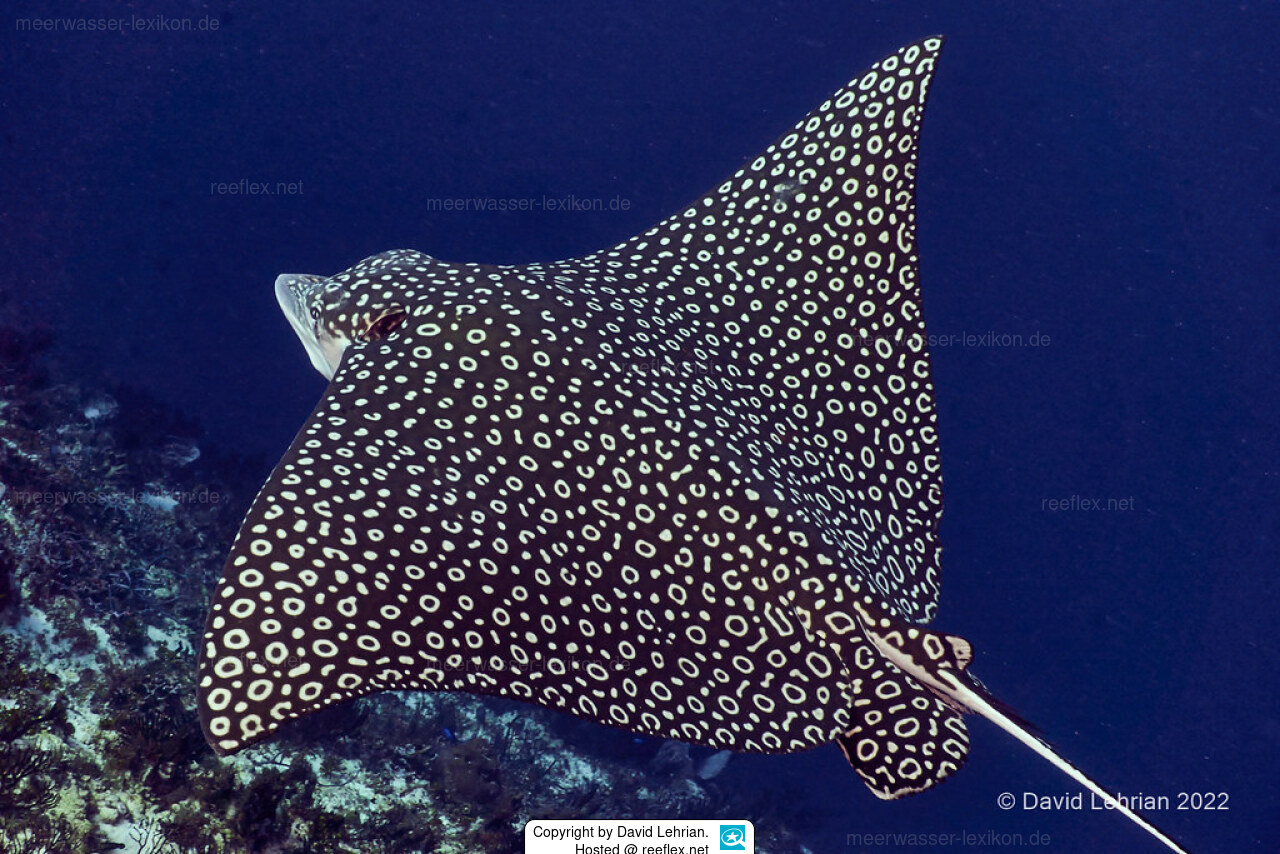Info
(Euphrasen, 1790)
Distribution:
Western Atlantic: North Carolina (summer) and Florida, USA and Bermuda to southern Brazil. Throughout Gulf of Mexico and Caribbean, including Antilles.
Eastern Atlantic: Mauritania to Angola.
Indo-West Pacific: Red Sea and South Africa to Hawaiii, north to Japan, south to Australia.
Eastern Pacific: Gulf of California to Puerto Pizarro, Peru and the Galapagos Islands.
There may be more than one species of spotted Aetobatus.
Based on combined genealogical concordance and genetic distance criteria.
Biology:
Commonly found in shallow inshore waters such as bays and coral reefs but may cross oceanic basins.
Benthopelagic, found near land at 1-60 m. Sometimes enters estuaries.
Swims close to the surface, occasionally leaping out of the water, or close to the bottom. Frequently forming large schools during the non-breeding season.
Feeds mainly on bivalves but also eats shrimps, crabs, octopus and worms, whelks, and small fishes.
Ovoviviparous, flesh edible.
Over 3 m disc width and up to 880 cm total length if the long tail is undamaged.
Bears young in litters of 2-4.
Tail used as a decorative item.
Common catch of the demersal tangle net, bottom trawl, inshore gillnet and, to a lesser extent, demersal longline fisheries.
Utilized for its meat and cartilage.
Synonymised taxa:
Aetobates narinari (Euphrasen, 1790) (misspelling)
Aetobatis latirostris Duméril, 1861
Aetobatis narinari (Euphrasen, 1790) (misspelling)
Myliobatis eeltenkee Rüppell, 1837
Myliobatis macroptera McClelland, 1841
Myliobatis punctatus Maclay & Macleay, 1886
Raia quinqueaculeata Quoy & Gaimard, 1824
Raja narinari Euphrasen, 1790
Stoasodon narinari (Euphrasen, 1790)
Distribution:
Western Atlantic: North Carolina (summer) and Florida, USA and Bermuda to southern Brazil. Throughout Gulf of Mexico and Caribbean, including Antilles.
Eastern Atlantic: Mauritania to Angola.
Indo-West Pacific: Red Sea and South Africa to Hawaiii, north to Japan, south to Australia.
Eastern Pacific: Gulf of California to Puerto Pizarro, Peru and the Galapagos Islands.
There may be more than one species of spotted Aetobatus.
Based on combined genealogical concordance and genetic distance criteria.
Biology:
Commonly found in shallow inshore waters such as bays and coral reefs but may cross oceanic basins.
Benthopelagic, found near land at 1-60 m. Sometimes enters estuaries.
Swims close to the surface, occasionally leaping out of the water, or close to the bottom. Frequently forming large schools during the non-breeding season.
Feeds mainly on bivalves but also eats shrimps, crabs, octopus and worms, whelks, and small fishes.
Ovoviviparous, flesh edible.
Over 3 m disc width and up to 880 cm total length if the long tail is undamaged.
Bears young in litters of 2-4.
Tail used as a decorative item.
Common catch of the demersal tangle net, bottom trawl, inshore gillnet and, to a lesser extent, demersal longline fisheries.
Utilized for its meat and cartilage.
Synonymised taxa:
Aetobates narinari (Euphrasen, 1790) (misspelling)
Aetobatis latirostris Duméril, 1861
Aetobatis narinari (Euphrasen, 1790) (misspelling)
Myliobatis eeltenkee Rüppell, 1837
Myliobatis macroptera McClelland, 1841
Myliobatis punctatus Maclay & Macleay, 1886
Raia quinqueaculeata Quoy & Gaimard, 1824
Raja narinari Euphrasen, 1790
Stoasodon narinari (Euphrasen, 1790)







 David Lehrian
David Lehrian













